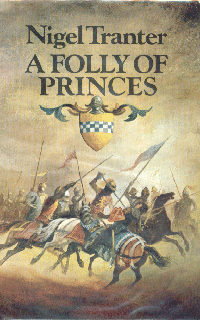

![]()
![]()
![]()
![]()

![]()
If Robert the Second's weaknesses stemmed from laziness, blindness and senility, his son Robert the Third's were more endemic, being born in him, and aided by piety and the kick of a Douglas horse. And Scotland ever needed a strong hand on the helm. The King's son and the King's brother were both possessed of strong hands, but that scarcely solved Scotland's problems at the turn of the 14th -15th century - since they pulled the helm in different directions, neither greatly concerned with the ship-of-state's course. Whilst the Douglases waited, biding their time.
Sir Jamie Douglas of Aberdour was, somewhat doubtfully, young Prince David Stewart's man, with a whole skeleton of bones to pick with the Earl Robert Stewart of Fife and Menteith, Governor of the Realm - an awkward and dangerous situation. Being married to the King's illegitimate sister held its own complications. But having a conscience was worse, and cost him dear in that company. Serving Stewart, like Mammon, demanded a single mind.
From the public carnage of the great clan fight on the North Inch of Perth to the turn-of-the century's revelries in the King's Park of Stirling, from the siege of Edinburgh Castle to the victory of Glen Arkaig, from the terrible death-by-starvation at Falkland to the disasterous field of Hamildon Hill, Jamie Douglas picked his hazardous way, while the power-struggle raged, the Scot's people paid, and the King prayed. England's King Richard the Second and Henry the Fourth were less religiously inclined and took a hand, inevitably.
In this, the second of his trilogy on the rise of the House of Stewart, Nigel Tranter paints a colourful and dramatic picture of a comparatively little known period's story with the blend of historical knowledge and personal enthusiasm which makes for the great story-telling expected by readers of " The Wallace " and " Lords of Misrule "
![]()